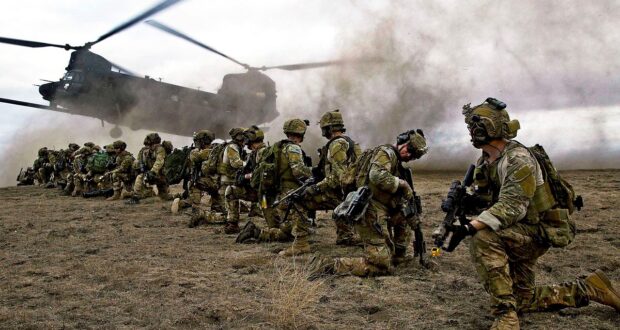19 October, 2020
By Jack Davies – Junior Fellow
We live in a ‘golden age’ of special operations forces (‘SOF’). The tactical, strategic, political and financial advantages afforded by SOF in fighting irregular conflicts such as the counter-terrorism and counter-insurgency campaigns that characterise the global war on terror (GWOT) have made them a highly desired tool for Western states engaged in these gruelling, seemingly endless wars. In particular, the covert nature and light footprint of SOF offers states seeking to minimize public perception of their ongoing foreign interventions a useful tool for action where legal or political restrictions would otherwise prevent conventional operations. This article focuses primarily on four Anglosphere states – the United States (US), United Kingdom (UK), Australia and Canada, chosen both because of their shared political and strategic ties and due to having deployed SOF as part of the GWOT.
The same covert nature that make SOF a potentially appealing tool also makes it difficult to obtain concrete evidence of their use and its effectiveness. While the extent of this lack of information varies between states, it is a consistent feature in each of the four focused on here. Nonetheless, what information has been made publicly accessible through official sources, leaked documents and open-source investigations reveals a pattern of SOF deployment that, at the very least, raises concerns that some governments view them as being ideal for circumventing legal and political restrictions and accountability.
Where states deploy SOF
Within international law, the Charter of the United Nations dictates that the use of force within the territory of another state is only legally justified in three circumstances: (1) in self-defence, (2) with Chapter VII UN Security Council authorization, and (3) with the consent of said state. Acting with Security Council authorization involves an often lengthy and necessarily public debate, usually preceding large-scale conventional interventions. In contemporary counter-terrorism and counter-insurgency conflicts, however, where a lighter footprint is often preferred for both political and operational reasons, invoking the right to self-defence and/or host state consent is more common.
The US is by far the most globally militarily active state, with US SOF being deployed to an astonishing 133 states around the world in 2014. Agreements with host states are often classified or otherwise not publicly announced, so it is impossible to say for sure how many of these deployments were justified by consent compared with self-defence. Often the US prefers to use both justifications, invoking the right to self-defence in response to the 9/11 attacks while securing consent where possible. This is currently the case for US operations in Afghanistan, Iraq, Somalia, Libya and Yemen, as well as in at least 22 states in Africa. While the resort to self-defence in the context of the GWOT has been the subject of extensive legal analysis, consent by host states is legally relatively uncontroversial.
It appears likely, therefore, that the deployment of US SOF in various states across the globe does not violate international law. However, the general lack of oversight and transparency regarding SOF deployment makes it impossible to know for sure – an issue not unique to the US. The deployment of Canadian SOF is highly secretive, with the Canadian Parliament commenting in 2006 that:
‘There have been unsubstantiated rumours of [SOF] operating in a number of foreign locations […] Canadians do not know where our [SOF] is operating, under what authorities, and under what rules of engagement’.
This comment points to the second legal question surrounding the use of force. While the deployment of military force may be legal in any given territory so long as it complies with the UN Charter, it must also abide by jus in bello – the legal rules governing the conduct of the use of force.
How states deploy SOF
Whether or not SOF are acting in accordance with jus in bello in any given operation depends on the context that operation occurs in. If an operation is conducted in the context of an armed conflict, the applicable legal framework is International Humanitarian Law (IHL), whereas outside of an armed conflict the more restrictive International Human Rights Law (IHRL) applies. IHL permits SOF to use force with considerable flexibility, so long as it abides by the principles of proportionality, necessity and distinction. However, outside of armed conflict, IHRL introduces restrictions that make it extremely difficult to use force legally.
In any given mission SOF operate under rules of engagement (ROE). ROE are not legal frameworks: according to the UK Ministry of Defence’s Development, Concepts and Doctrine Centre they are operational guidance drawn up individually by each state that tell the troops what they can or cannot do, ‘expressed as permissions and prohibitions which govern where armed forces can go, what they can do and, to an extent, how and when certain actions can be carried out’. As SOF operate in a wide range of contexts, both inside and outside of armed conflict, ROE can vary significantly both between any given situation or even between different states’ SOF operating within the same context. Due to the politically and strategically sensitive nature of SOF operations, the ROE for SOF missions, especially those outside of armed conflict, are usually classified. What is known from media investigations and leaked documents is that SOF conduct a range of combat and non-combat missions, including intelligence, surveillance and reconnaissance (ISR), advise, assist and accompany (AAA) missions, and targeted killings.
Much of the legal debate surrounding targeted killings has focused on drone strikes. However, it is important to recognise that SOF play a major role in direct action operations. Between 2005-2007 a joint UK-US SOF campaign killed an estimated 3,000 insurgents in Iraq, whilst in Afghanistan a JSOC-led US, UK, Australian and Canadian SOF collaboration of 13,000 personnel worked through a ‘kill list’ of Taliban leaders. Lastly, in Syria, the UK SOF conducted a targeted ‘kill or capture’ campaign against 200 British-nationality members of Daesh. These campaigns have typically occurred within armed conflict where there is consensus that IHL applies. Nevertheless, due to issues with targeting practices, the practice of targeted killing remains legally problematic.
Outside of armed conflict, SOF are more often engaged in ostensibly non-combat operations than direct action. However, the distinction is not always clearly marked. AAA missions, which primarily involve SOF training and advising partner forces, often blur the lines between the two. Discussing US insistence that SOF were conducting a strictly non-combat AAA in Iraq after Peshmerga fighters released videos of American soldiers engaged in gunfights, a former US State Department advisor said:
‘The issue is really situational. You’re advising and assisting but put in situations that are much closer to engagement and combat. In those circumstances, I suspect the line becomes a very fine one – a matter of metres […] There’s a very fine distinction’.
Reporting has confirmed that US SOF conducted at least 200 such AAA missions with partner forces against al-Shabaab between 2017-2018 alone, including AAA operations in Ethiopia, Somalia, Kenya and Uganda. More troubling is that it appears in some instances that the AAA label has been used to insert SOF into conflicts and achieve states’ objectives where there is no legal basis to do so. In Libya, despite a UN Security Council resolution limiting NATO intervention to civilian protection, UK, US and Canadian SOF were instrumental in overthrowing Mummar Gaddafi, skirting legal boundaries by providing crucial support to rebel groups as trainers, advisors and air strike coordinators. Most concerning is why SOF are deployed in these contexts – they are perceived by states as the ideal tool for politically sensitive, legally problematic, operations.
The Perception of SOF by States
Public comments regarding SOF by government officials are rare. However, by considering the actions of military and political leaders, we find a perception that they can and should be able to act without robust public oversight or legal constraint.
The drive to reduce publicly perceived risk has been identified as a hallmark of the remote warfare strategies that characterise Western counter-terror military interventions. Awareness that large scale, ‘boots on the ground’ conventional campaigns are deeply unpopular and politically costly have driven Western governments towards tools and tactics which offer a less visible alternative for conducting lethal operations in foreign states, including the widespread use of drones, private military contractors, partner forces and SOF. This fact was stressed by the UK Ministry of Defence, who identified that, ‘The use of [SOF] brings two factors into play, namely the likelihood of large numbers being lost is small, and the public appear to have a more robust attitude to [SOF] losses’. In effect, SOF offer governments an effective means of continuing militarized counter-terrorism through far less visible means.
It is therefore unsurprising that their deployment and conduct is subject to barely any public scrutiny. When four US SOF were killed in a failed 2017 raid in Niger, politicians claimed to have been completely unaware that the US military was deployed in West Africa at all. The Niger raid was subsequently subject to an investigation resulting in a 6,000-page classified report. However, in other states even this ‘after-the-fact’ oversight is absent. When probable UK SOF Sergeant Matt Tonroe was killed in 2018 in Manbij, Syria, the UK MoD fell back on its controversial blanket policy of secrecy regarding SOF, unique among the Anglosphere states, offering ‘no comment’. The deployment of UK SOF to Syria is especially notable as it followed the UK Parliament voting against conducting airstrikes in Syria in 2013 – SOF were perceived as a quiet alternative that would allow the government to bypass scrutiny. When Parliament did eventually authorize air strikes in Syria in 2015, SOF were conspicuously absent from the debate. Finally, consider that for the first 15 years of the global war on terror, during which UK, Australian and Canadian SOF were not specifically subject to public parliamentary scrutiny at all.
Legal accountability is also lacking for SOF. Despite repeated claims that numerous states’ SOF have committed war crimes, including UK SOF troops being accused of adopting a ‘deliberate policy’ of executing unarmed prisoners in Afghanistan, and Australian SOF killing unarmed Afghan civilians (currently the subject of a private inquiry), there are few public cases to point to of legal accountability for SOF actions. One notable effort, ‘Operation Northmoor’, launched by the UK’s Royal Military Police in 2014, began with the intention of investigating 52 allegations of illegal killings by SOF between 2010-2013, before eventually being reduced as a result of political pressure to investigating just one incident. More recently, a disturbing trend has emerged within both the US and UK of viewing legal accountability as a threat to an effective military. In the US, President Trump made headlines by pardoning SOF Chief Edward Gallagher, continuing a trend of protecting troops from accountability even when found guilty of illegal action. In the UK a perception that litigation is a critical challenge for the military suffuses policy-makers, sparking the proposal of the controversial ‘Overseas Operations Bill’ by the government.
Ultimately, there is a difference between deploying SOF because a state consciously intends to violate legal constraints and sending SOF because, if the law is violated, the lack of oversight will make it easier to avoid accountability and litigation. There may be no ‘smoking gun’ that proves governments consciously deploy SOF without regard for law. However, the intentional lack of public accountability, paired with patterns of potentially illegal deployment, indicate at a minimum a willingness to look the other way and not ask too many questions.
Acknowledgements: Deepest thanks to Abigail Watson and Megan Karlshøej-Pedersen for giving some of your time and insight. Your feedback was highly valuable and immensely appreciated!
Image: U.S. Army Rangers during a training exercise (Source: Specialist Steven Hitchcock, U.S. Army)
 Human Security Centre Human Rights and International Security Research
Human Security Centre Human Rights and International Security Research




